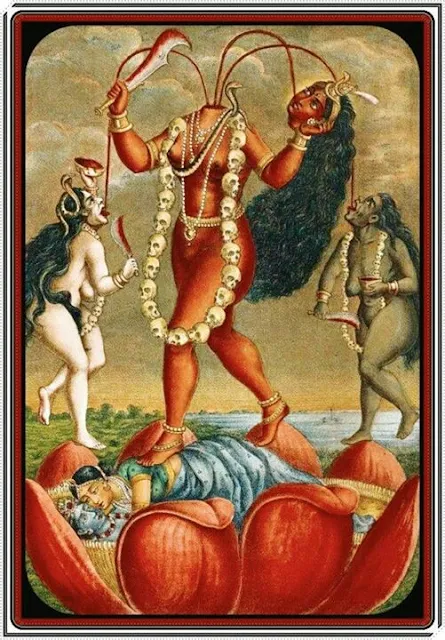 |
| The Sixth Great Cosmic Wisdom |
In the Tantric pantheon, the sixth Great Cosmic Wisdom is Chinnamasta, the goddess without a head.
This particularity suggests her capacity of transcending the mind and its functions, so that in the end she achieves the ecstatic union with the Supreme Void of the Absolute Divine Consciousness.
The headless image of the Great Cosmic Wisdom Chinnamasta caused along the centuries, many adverse reactions and erroneous interpretations even amongst the specialists in Hinduism, as she is associated with the obscure magical practices and traditions of Tibet and India.
In fact, these hasty considerations are only limited attempts from certain westerners to understand the deeply esoteric sense of certain aspects from the Tantric spiritual tradition, those aspects that go beyond modern people’s conventionalism and patterns built on preconceived ideas.
Consequently, the relatively natural tendency of the researchers of Hinduism, when facing representations of the Great Cosmic Wisdom Chinnamasta was to see the manifestation of some macabre aspects and psychic deviations.
Therefore, it was impossible for these researchers to accept the idea of spiritual symbolism with deep esoteric significations.
WISDOM TRANSCENDS MIND
From a psychological point of view, what really causes the feeling of fear and rejection for the idea of a headless entity is the idea of lack of identity, which people immediately associate with their own being.
 Or, we know that identity is the key element of “support” in manifestation, the basis of understanding and conception about the world. Once this idea or support was eliminated, people felt confused, with no point of reference, lost in a tenebrous unknown.
Or, we know that identity is the key element of “support” in manifestation, the basis of understanding and conception about the world. Once this idea or support was eliminated, people felt confused, with no point of reference, lost in a tenebrous unknown.Thus, people will unconsciously or consciously try to protect themselves, not only against losing their identity, but also from the idea or exterior suggestion implying this separation of identity or ego.
The modern man, whose behavior and way of thinking is mainly reasonable and logical, considers that “losing one’s head” equals losing touch with the regular sense of reality, which is nonetheless true from certain points of view.
However, from a spiritual point of view, these aspects have completely different significance’s.
For the yogis, being without head is one of the known subtle metaphors referring to the transcendence of one’s identification with bodily consciousness or to overcoming the attachment towards thoughts and desires.
Practically, we do not observe our head more than we notice the back of our body, and the experience of the inside of the skull is basically the experience of an empty space because nobody can say they “feel” their brain or the annex glands.
Consequently, during a lucid and detached analysis, from the symbolic perspective of these aspects, we can say that we “have no head” until the moment when we look at our body in the mirror.
From the yogic spiritual tradition, the condition of the headless state represents in fact our true inner nature, of the divine and perfectly detached witness.
Implicitly, this condition proves that our present “location” in this body is not more than an illusory appearance and not the fundamental reality of our being.
If, in fact if the powerful and constant thought “I am the body” would no longer be sustained by the mind, the individual consciousness would gradually go back to its original condition, that which is not dependant on either form or thought.
Furthermore, this idea is frequently used as a spiritual metaphor in the spiritual tradition of Jnana yoga, Advaita Vedanta and Zen.







